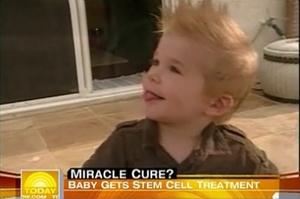
Researchers at the Medical College of Georgia have begun the first full scale clinical trial to test if stem cells from a child’s own umbilical cord (autologous) can help treat Cerebral Palsy. CP, which affects 2-3 children per thousand in the US, is caused by oxygen deprivation before birth or in the early year of life, and can cause severe motor and mental impairment. The MCG team follows on the heels of a pilot study at Duke University which is exploring if cord blood can be readily applied to infant’s with palsy like symptoms in the first two weeks after birth. Both teams are looking to verify the anecdotal evidence that cord stem cells can be used to ‘cure’ CP children. If successful, the work at MCG and Duke University may provide parents with hope that storing a child’s cord blood could be an effective shield against cerebral palsy.
The anecdotal evidence in support of treating cerebral palsy with cord blood stem cells is astounding. Much of it has actually been been performed at Duke University by one of the investigators in the pilot study: Joanne Kurtzberg. Among those that have been successfully treated at Duke include Ryan Schneider, Maia Friedlander, Chloe Levine, and Dallas Hextell. All had CP or CP-like symptoms and all made remarkable recoveries after cord blood stem cell treatments. Dallas Hextell, who showed improvements just 5 days after his therapy was featured on the Today show:
As powerful as anecdotal evidence may be, it is not a scientific basis for a new therapy (despite Nancy Snyderman’s enthusiastic comments). Luckily James Carroll, the head researcher for the clinical trials at MCG, has had success with treating oxygen related brain damage in animal tests. Rats with induced CP-like conditions were shown to have improved motor skills after multipotent adult progenitor stem cells were introduced. In MCG’s human clinical trials children aged 2 to 12 will be given infusions (half will receive cord blood stem cells, half placebo) and then examined three months later. At that point, the placeboed half of the patients will receive cord blood stem cells. Examinations will continue three and six months later.
The Duke University pilot study is aimed at evaluating a quick response to cerebral palsy in infants. Infants that show signs of CP in the first two weeks after birth, and whose parents have consented to cord blood drawing, will have their stem cells infused into them. Examinations (including MRI and extend stays at Duke’s Special Infant Care Clinic) will take place in the months following.
Trying to decide which study has a better basis or chance for success is somewhat besides the point. It doesn’t really matter if MCG or Duke is the first to provide rigorous data in support of cord blood stem cell treatments for palsy, the work is getting done. That’s very exciting news for parents with young children suffering from CP. Those interested should note that (at the time of writing) both studies are still actively recruiting. However, the MCG study will only allow those children with cord blood stored at the Cord Blood Registry in Tuscon (to maintain consistency in the trial), and Duke University has similar restrictions.
These trials may influence even more parents to store their child’s cord blood after birth. Cord blood banks, like CBR, actively use anecdotal evidence of cerebral palsy cures in their advertising. The stories of all of the children listed above can be found on various cord blood bank sites. I don’t want to ape their sentiments too closely, but I do tend to agree that cord blood storage may be a good idea. Cerebral palsy’s effects are not always seen quickly, and storing cord blood could be useful even if your child shows no immediate CP symptoms. Furthermore, palsy is just one of the conditions that may be treatable with umbilical stem cells. As I mentioned when we first discussed storing cord blood, you can always register your child’s cells so that they can be donated to another child if your own does not need them.
So we have some exciting news for cerebral palsy, and some exciting news for those thinking about cord blood. What about the rest of us? Well the MCG and Duke work has some far reaching implications. Neurological damage, whether it’s caused by oxygen deprivation or some other injury, is one of the most difficult things to heal in the body. Work in animals (like that done by Carroll on rats) show that stem cells can not only help damaged brain cells recover, but they can also replace cells that have died. We may find that stem cells therapies have a wide range of applications for many different forms of brain damage. Kurtzberg is researching many different ways cord blood could be used (autologous or through donors) to treat a variety of conditions. In other words, today stem cells conquer cerebral palsy…tomorrow, the world.
[screen capture and video credit: Today, MSNBC]
[source: ClinicalTrials.gov, MCG News, Carroll et al, PubMed]


